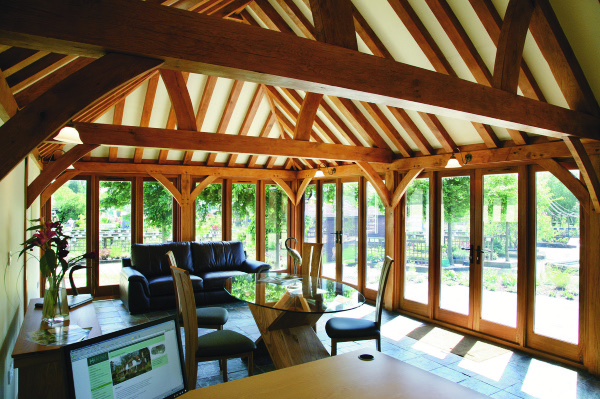
Why we should all be considering a Dry Build as a construction alternative
Darren Hook, Managing Director of English Heritage Buildings, explores the growing popularity of Dry Build construction within the industry.
As technology improves, there are an increasing number of construction offerings available. The industry is constantly on the lookout for faster, smarter and more economical approaches, whilst also keeping an eye on their environmental credentials.
Dry Build constructions are becoming an ever-more popular alternative to traditional building methods. The concept itself is not new, but the implications and benefits have only recently started to be fully appreciated. With the housing market growing across the board, both in terms of an increased need for affordable housing and Brexit encouraging home-owners to ‘improve, don’t move’ the need for better building options has never been greater.
The concept is simple; a Dry Build engages the same fundamental methods as traditional bricks and mortar building, but uses different materials. ‘Dry’ materials include wood, gypsum board and plywood. When used instead of traditional moisture-retaining materials such as concrete and plaster the impact on build time, finances and eventually energy efficiency are incomparable.
Wood has a physical quality not available in man-made materials; it provides sound insulation, keeps interiors at a constant temperature and, surprisingly offers more safety in the case of a fire. It also provides an infinitely malleable and multi-functional surface, affording designers almost unlimited freedom in their work.
The construction system itself is also much more versatile and faster, in fact construction time can be cut by up to half when compared to traditional wet construction involving bricks and blocks. The implications for house builders are immeasurable, as earlier occupancy means earlier income, and bespoke projects can take place with minimum impact and fuss. The Dry Build technique also requires much less water and generates minimum construction waste, making much less of an impact on the local environment.
Not only does a Dry Build reduce waste and time commitments, the materials used are also cost effective, more durable, stronger, lighter and more adaptable, leading to greater flexibility in construction design
When it comes to financial benefit, the real cost-effectiveness relies on key features such as speed of installation, as well as being low maintenance and easy to repair. The materials are easily optimised, so there is minimal wastage.
Dry Build construction is a well-known phenomenon, but it is still largely uncommon. In most situations its purpose is not to replace traditional wet methods, but complement them and create an alternative for builders. When it comes to adding an aesthetic extension to a property a Dry Build is becoming an increasingly popular alternative.
One comment on “Why we should all be considering a Dry Build as a construction alternative”
Leave a Reply
You must be logged in to post a comment.
Latest news

30th April 2025
Digital Construction Week announces seminar programme for its landmark 10th edition
Digital Construction Week (DCW) returns to ExCeL London on 4 – 5 June 2025 with its most impactful programme yet. It brings together the best and brightest from across AECO, for two days of practical learning and idea sharing.
Posted in Articles, Building Industry Events, Building Industry News, Building Products & Structures, Building Services, Building Systems, Exhibitions and Conferences, Information Technology, news, Restoration & Refurbishment, Retrofit & Renovation, Seminars
29th April 2025
Senior pledges to ‘bee’ part of the solution with new biodiversity initiative
Senior Architectural Systems has installed its first on-site beehive, marking another step forward in its commitment to sustainability and biodiversity.
Posted in Articles, Building Industry News, Building Products & Structures, Building Services, Curtain Walling, Doors, Glass, Glazing, Innovations & New Products, news, Restoration & Refurbishment, Retrofit & Renovation, Sustainability & Energy Efficiency, Walls, Windows
29th April 2025
West Fraser range delivering key benefits for South-East carpentry company
An experienced carpenter and building site manager who has recently set up his own company is using high performance panel products from the West Fraser range.
Posted in Articles, Building Industry News, Building Products & Structures, Building Systems, Case Studies, Garden, Restoration & Refurbishment, Retrofit & Renovation, Sustainability & Energy Efficiency, Timber Buildings and Timber Products
29th April 2025
CPD Courses Available Online From Ecological Building Systems
Ecological Building Systems, a leading supplier of natural building products for sustainable construction, has revealed its comprehensive CPD programme for the year ahead.
Posted in Articles, Building Industry Events, Building Industry News, Building Products & Structures, Building Services, Continuing Professional Development (CPD's), Information Technology, Innovations & New Products, Insulation, Restoration & Refurbishment, Retrofit & Renovation, Seminars, Sustainability & Energy Efficiency, Training, Walls, Waste Management & Recycling



Not sure if dry build is an option in London. I have seen houses that has been build from wood and it just looks awful. After a year the wood has lost its beauty due to humidity. Though brick house looks the same for many years unlike wood house. Hence why we at https://www.proficiencyltd.co.uk suggest to stick to brick wall. Recently I went to Interior Show and there was one company who build house from cardboard. I though that was crazy maybe good idea to construct one of those houses abroad where it is mostly sunny.